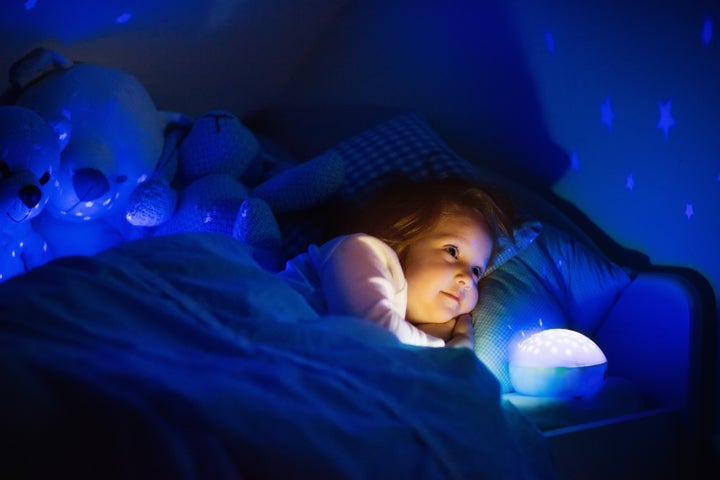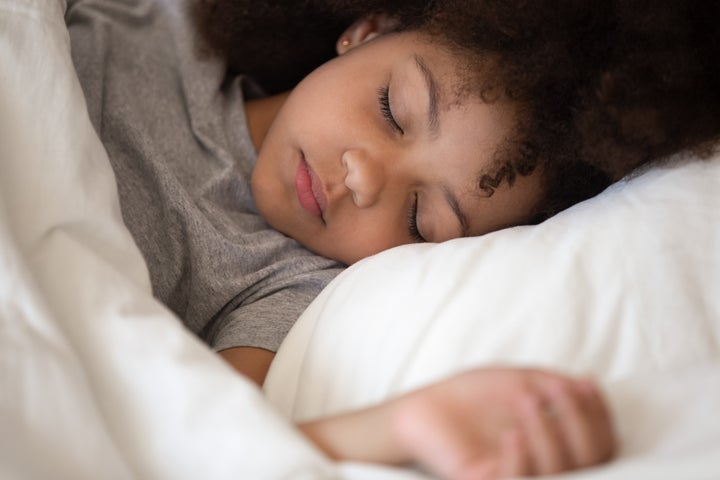
Imagine a world where saying “It’s bedtime!” was all it took for kids to fall asleep. Nice, right? But sadly, parents living in reality can’t relate.
That was the case with Jessica D’Entremont, a mother of two from Massachusetts who is no stranger to the exhausting ritual that is convincing your children to fall asleep. She had her hands full one evening with her two daughters, Hannelore, 3, and Emma, 4, who weren’t running out of steam anytime soon.
“Their routine was disrupted due to a fundraiser I had that morning for my work… So they were particularly hyper and running around on the verge of meltdown,” D’Entremont told Scary Mommy.
That’s when she came up with a brilliant scheme: a few words that instantly had her daughters ready for shuteye. And it involved some glow-in-the-dark pyjamas.
“Tell them they have to lie really still under the light to ‘charge’ them,” she wrote on Facebook.
D’Entremont shared a photo on Facebook of her two little ones quietly “charging” their sleepwear on the floor, and it soon went viral.
The post has racked up over 132,000 shares on Facebook, with fellow parents commiserating over bedtime woes and sharing excitement for the strategy to get their kids into dreamland faster.
Following the massive response, D’Entremont had another helpful tip for parents: she makes the fib more believable by hiding the pyjamas in a drawer in the day, where they wouldn’t glow.
Where to buy glow-in-the-dark PJs in Canada
All product choices are made independently by our editors. HuffPost Canada may receive a share from purchases made via links on this page.
D’Entremont told HuffPost Canada she’s unsure of the specific pyjama brand that her daughters wear, but that they’re a big fan of sleepwear from Portland-based brand Hanna Andersson.
If you’re not willing to pay U.S. shipping, there’s good news: thanks to Halloween, there’s glow-in-the-dark fashion galore in Canada. Most major retailers, such as Joe Fresh, Old Navy, and Osh Kosh B’Gosh have a variety of illuminating sleepwear options, many taking the form of skeleton designs.
The bad news: a glowing skeleton will live in your home. So. There’s that.
If you’re not keen on raising a pile of bones, many glow-in-the-dark pyjamas are decorated with intergalactic themes. Fans of Peppa Pig and her brother George can twinkle all night with this rocket-powered set from Amazon.
Or go prehistoric with this set of dinosaur fossil jammies from Hatley.
If you don’t mind paying a little more, Pottery Barn Kids has several year-round sleepwear styles that glow, including a superhero set with characters that pop in the dark and a festive Nutcracker set with glowing snowflakes.
The kicker? Pottery Barn actually recommends charging these outfits under a bright light for about 30 minutes to “glow properly.” So maybe you won’t have to employ any underhanded comments after all.
A ‘sensory diet’ for bedtime
D’Entremont’s daughters both have Sensory Processing Disorder (SPD), making it easy for the two children to be stressed by the sights, smells, and sounds around them. Every child with SPD may process senses differently: some may get frustrated with how certain items of clothing feel. Others may find certain sounds like loud music or alarms intolerable.
For kids who feel overwhelmed by their senses, entering a state of mind that is ready for sleep can be challenging. That’s why aside from the pyjamas, the mother of two has a “sensory diet” that primes her kids for bed.
More from HuffPost: The truth about getting sleep with a newborn. Story continues below.
“We also use essential oils to help support sleep and calm so this is a great way to get some stillness,” she told Pop Sugar.
Sensory diets refer to the routine for someone with SPD that balances out what they are overstimulated by. For kids who need to transition from a high energy day to a tranquil night, Psychology Today recommends a sensory diet filled with quiet activities.

What that diet entails will depend on if a child is “sensory-seeking,” meaning they draw comfort from having a particular sensation felt, or “sensory-avoidant,” in which they can’t tolerate some sensations.
Sleep specialist Lauren Peacock suggests tailoring the sleep diet to either. For example, a sensory-seeking child who wants a heavy physical sensation might need a weighted blanket to sleep through the night. A sensory-avoidant child could sleep better if skin-irritating tags were removed from their clothing.
Also from HuffPost: